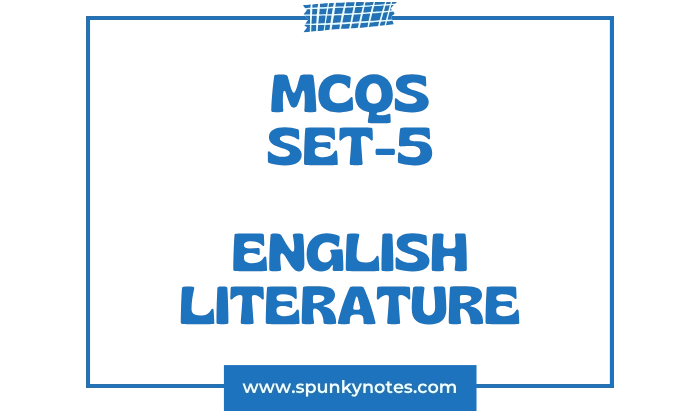

Estimated Reading Time: 16 min
English Literature MCQs
Set-5
1. Which of the following plays of Shakespeare is considered a ‘problem play’?
A. A Midsummer Night’s Dream
B. Measure for Measure
C. Much Ado About Nothing
D. Twelfth Night
2. Identify the dramatist who wrote only tragedies :
A. Thomas Kyd
B. John Webster
C. Christopher Marlowe
D. Thomas Dekker
3. Arcadia is a:
A. Tragedy
B. Play
C. Allegory
D. Romance
4. The twelve Knights in Faerie Queene represent twelve :
A. Disciplines
B. Virtues
C. Castles
D. Passions
5. The Mystery Plays dealt with:
A. Biblical themes
B. Moral allegories
C. Lives of saints
D. History of the monarchy
6. What is the central theme in the Restoration Comedy ?
A. War and Politics
B. Religion and Morality
C. Money and Matrimony
D. Peasants and Power
7. Who was the wife of Antony ?
A. Octavia
B. Cleopatra
C. Fulvia
D. Charmian
8. The character of Sin in Milton’s Paradise Lost is portrayed as
A. Satan’s loyal servant
B. A beautiful angel
C. The daughter-cum-beloved of Satan
D. A neutral observer
9. Bunyan’s The Pilgrim’s Progress (Part I) was published in the year :
A. 1660
B. 1675
C. 1678
D. 1684
10. Leviathan is authored by
A. John Locke
B. David Hume
C. Francis Bacon
D. Thomas Hobbes
11. Who among the following is one of the four wheels of the English novel?
A. Jane Austen
B. Walter Scott
C. Charles Dickens
D. George Eliot
12. In which poet’s poem does the character of Belinda occur?
A. John Dryden
B. Jonathan Swift
C. Alexander Pope
D. John Milton
13. Whose name is associated with The Spectator:
A. Jonathan Swift
B. Joseph Addison
C. Samuel Johnson
D. Alexander Pope
14. “When lovely woman stoop to folly” appears in a work by
A. Alexander Pope
B. Samuel Johnson
C. Oliver Goldsmith
D. George Eliot
15. Who has written the treatise On Liberty?
A. Thomas Hobbes
B. John Stuart Mill
C. John Locke
D. Edmund Burke
16. “We are laid asleep in body and become a living soul.” In which poem of Wordsworth do these lines occur?
A. “The Prelude”
B. “Immortality Ode”
C. “Tintern Abbey”
D. “The Excursion”
17. Who is the author of Biographia Literaria ?
A. S.T. Coleridge
B. William Wordsworth
C. Thomas De Quincey
D. Charles Lamb
18. A Vindication of the Rights of Women is written by:
A. Virginia Woolf
B. Jane Austen
C. Mary Wollstonecraft
D. Margaret Atwood
19. Arrange the following in the right chronological order:
A. Preface to Lyrical Ballads – Lyrical Ballads – Biographia Literaria – Adonais
B. Biographia Literaria – Lyrical Ballads – Preface to Lyrical Ballads – Adonais
C. Lyrical Ballads – Preface to Lyrical Ballads – Biographia Literaria – Adonais
D. Adonais – Lyrical Ballads – Preface to Lyrical Ballads – Biographia Literaria
20. “Elia” is a pen-name assumed by:
A. Thomas De Quincey
B. William Hazlitt
C. Leigh Hunt
D. Charles Lamb
21. In one of his novels Hardy says, “Happiness is but an occasional episode in the general drama of pain.” In which novel do these lines appear ?
A. Jude the Obscure
B. Tess of the d’Urbervilles
C. The Return of the Native
D. The Mayor of Casterbridge
22. Eugene Marchbanks is a character in Shaw’s:
A. Pygmalion
B. Arms and the Man
C. Major Barbara
D. Candida
23. Who defines poetry as a “criticism of life” :
A. Matthew Arnold
B. T.S. Eliot
C. S.T. Coleridge
D. William Hazlitt
24. Which work of Dickens has as many as three hundred and fifty six characters:
A. Hard Times
B. Bleak House
C. Great Expectations
D. David Copperfield
25. Who has used these words: “that monstrous tuberosity of Civilizéd Life the Capital of England”?
A. Thomas Carlyle
B. Charles Dickens
C. William Wordsworth
D. Ruskin
26. “The poem must become more and more comprehensive, more more indirect, in order to force, to dislocate if necessary, language into its meaning.” Who wrote this:
A. Ezra Pound
B. W.B. Yeats
C. T.S. Eliot
D. Wallace Stevens
27. “A terrible beauty is born” is a line from:
A. W.B. Yeats’ Easter 1916
B. T.S. Eliot’s The Waste Land
C. James Joyce’s Ulysses
D. Seamus Heaney’s North
28. “The Comedy of Menace” is a term we associate with:
A. Arthur Miller
B. Eugene Ionesco
C. Harold Pinter
D. Samuel Beckett
29. What is the source of the line: “Nothing happens, nobody comes, nobody goes, it’s awful!”
A. Pinter’s The Dúmb Waiter
B. Beckett’s Waiting for Godot
C. Shaw’s Widowers’ Houses
D. Ionesco’s The Chairs
30. Choose the correct chronological order of the following events:
A. Beginning of the First World War, Easter Rising in Ireland, The Russian Revolution, The Publication of The Wasteland
B. Easter Rising in Ireland, Beginning of the First World War, The Russian Revolution, The Publication of The Wasteland
C. Beginning of the First World War, The Russian Revolution, Easter Rising in Ireland, The Publication of The Wasteland
D. The Russian Revolution, Beginning of the First World War, Easter Rising in Ireland, The Publication of The Wasteland
31. The Feminine Mystique is a work by:
A. Simone de Beauvoir
B. Germaine Greer
C. Betty Frieden
D. Kate Millett
32. “Dying is an art and I do it exceptionally well.” These lines are by :
A. T.S. Eliot
B. Anne Sexton
C. Ted Hughes
D. Sylvia Plath
33. Which of the following is a dystopian novel?
A. Brave New World
B. The Great Gatsby
C. Nineteen Eighty Four
D. Women in Love
34. Name the author of The Loneliness of Long Distance Runner:
A. John Osborne
B. Alan Sillitoe
C. Alan Sillitoe
D. Kingsley Amis
35. Which of the following novelists has won the Booker Prize twice?
A. J.G. Ballard
B. V.S. Naipaul
C. J.M. Coetzee
D. Nadine Gordimer
36. Name the author of The Golden Notebook :
A. Iris Murdoch
B. Muriel Spark
C. Doris Lessing
D. Margaret Drabble
37. The narrative style of Salman Rushdie’s Midnight’s Children shows the influence of :
A. Naturalism
B. Magic realism
C. Social realism
D. Stream of consciousness
38. Which of the following novels is by Rohinton Mistry:
A. Such a Long Journey
B. A Fine Balance
C. The Golden Gate
D. Fasting, Feasting
39. Wide Sargasso Sea by Jean Rhys is a rewriting of :
A. Jane Austen’s Pride and Prejudice
B. Emily Brontë’s Wuthering Heights
C. Thomas Hardy’s Tess of the d’Urbervilles
D. Charlotte Brontë’s Jane Eyre
40. Gitanjali was selected for the Nobel Prize for literature in the year :
A. 1913
B. 1916
C. 1919
D. 1923
41. Who has suggested the idea of tenor and vehicle in the analysis of ‘Metaphor’:
A. Cleanth Brooks
B. I.A. Richards
C. Northrop Frye
D. Allen Tate
42. ‘Deconstruction’ is a term we associate with:
A. Michel Foucault
B. Jacques Derrida
C. Roland Barthes
D. Jacques Lacan
43. Who called Shelley “an ineffectual angel beating in the void his luminous wings in vain”?
A. T.S. Eliot
B. Matthew Arnold
C. S.T. Coleridge
D. William Hazlitt
44. Who among the following is not considered a New Critic?
A. Terry Eagleton
B. Cleanth Brooks
C. W.K. Wimsatt
D. Allen Tate
45. The book, The Mad Woman in the Attic, is an example of:
A. Structuralism
B. Feminist Criticism
C. New Historicism
D. Psychoanalytic Criticism
46. ‘Caesura’ means :
A. the break in a stanza
B. a strong pause in a line
C. the end of a line
D. a line with a feminine ending
47. ‘Iamb’ is a metre with:
A. a stressed syllable followed by an unstressed one
B. two unstressed syllables followed by a stressed one
C. two stressed syllables
D. an unstressed syllable followed by a stressed one
48. Synaesthesia is:
A. the confusion of ideas
B. the mixing of metaphors
C. the interpretation of one sense in terms of another.
D. the blending of different genres
49. Pastoral poetry deals with:
A. The life of shepherds and shepherdesses
B. urban problems
C. historical events
D. political satire
50. Petrarchan sonnet uses the following rhyme scheme:
A. abba abba cdc dcd
B. abba abba cde cde
C. abab cdcd efef gg
D. abab bcbc cdcd ee
Overview
This set of 50 multiple-choice questions begins with the Renaissance and tests knowledge of Shakespeare’s ‘problem plays’, Marlowe’s tragedies, and Spenser’s Faerie Queene.
The quiz moves to the 17th century, covering Milton’s Paradise Lost and Bunyan’s The Pilgrim’s Progress. Figures like Alexander Pope and Joseph Addison represent the 18th century.
A large portion covers the Romantic period (Wordsworth, Coleridge) and the Victorian era (Hardy, Dickens, Matthew Arnold).
The 20th century is marked by questions about Modernists such as T.S. Eliot and W.B. Yeats, as well as post-war figures like Samuel Beckett and Harold Pinter. The quiz also features contemporary and post-colonial writers, including Salman Rushdie, J.M. Coetzee, and Jean Rhys.
The final section is dedicated to literary theory, featuring terms such as ‘Deconstruction’ and ‘Feminist Criticism’, as well as technical poetic devices like ‘caesura’, ‘iamb’, and the ‘Petrarchan sonnet’.


